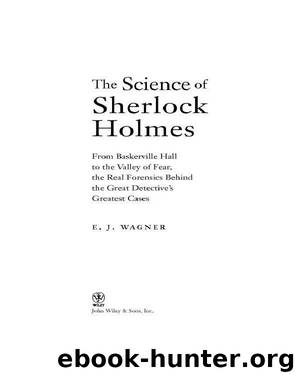Science of Sherlock Holmes by Wagner E. J

Author:Wagner, E. J.
Language: eng
Format: epub
Publisher: John Wiley & Sons
Published: 2010-12-01T16:00:00+00:00
But Bertha Merrett’s family and friends were insistent that suicide would have been abhorrent to her. There had been nothing in her demeanor prior to the shooting that indicated depression. Her statements in the hospital supported their view. Further, self-inflicted gunshots are unusual in females (although not unheard of), and the angle of the wound at the back of the head seemed awkward. The discovery by the bank that the young orphan had been embellishing his pocketbook by forging his mother’s name appeared suggestive.
Littlejohn, reconsidering, and aware of his former student’s expertise with gunshot wounds, asked for the opinion of Sydney Smith. Sir Sydney, going over the evidence, noted that the doctors at the infirmary had observed the lack of tattooing, or powder marks, around the bullet wound. The question was, he felt, would the weapon that made the wound leave such marks if discharged close enough to the head as to indicate suicide.
He suggested that Littlejohn experiment with the weapon that shot Bertha Merrett. Littlejohn procured the gun, which was a six-cartridge .25 Spanish automatic, loading it with the same type of ammunition used in the Merrett shooting. He fired it at a number of targets, including one made of the skin of a recently amputated leg. He measured the distance each time and discovered that at three inches or less, very obvious powder and burn marks appeared on the target. Marks appeared at six inches. These marks were not only evident to the naked eye, they were exceedingly difficult to remove. It took a distance of nine inches before no marks appeared, and certainly no one could shoot themselves behind the ear at such a long range. (The importance of powder marks was well known to Sherlock Holmes, who says in “The Reigate Squires”: “The wound upon the dead man was, as I was able to determine with absolute confidence, fired from a revolver at the distance of something over four yards. There was no powder-blackening on the clothes. Evidently, therefore, Alec Cunningham had lied when he said that the two men were struggling when the shot was fired.”)
Littlejohn, to his great credit, wrote a new report, stating that accident was “inconceivable, suicide in the highest degree improbable,” and that the circumstances “pointed to homicide.”
John Donald Merrett now received the rapt attention of the Scottish judicial system and was indicted on charges of both murder and forgery. Littlejohn, of course, would testify for the Crown. A guilty verdict seemed inevitable. And then Merrett’s attorney made an amazing announcement. The expert witness for the defense would be Sir Bernard Spilsbury.
Sir Bernard, the English Home Office pathologist, had a sterling reputation as a brilliant expert on homicide in general and shooting cases in particular. His fame, since his early foray into the public’s awareness during the Crippen case, had grown enormous, and his ability to impress a jury was formidable. His official position meant that in England he usually appeared for the Crown, so his appearance in Scotland on the side of the defense was startling.
Download
This site does not store any files on its server. We only index and link to content provided by other sites. Please contact the content providers to delete copyright contents if any and email us, we'll remove relevant links or contents immediately.
The Borden Murders by Sarah Miller(4273)
The Secret Barrister by The Secret Barrister(3660)
Police Exams Prep 2018-2019 by Kaplan Test Prep(2516)
Coroner's Journal by Louis Cataldie(2458)
The Splendid and the Vile by Erik Larson(2413)
Terrorist Cop by Mordecai Dzikansky & ROBERT SLATER(2051)
My Dark Places by James Ellroy(1910)
A Colony in a Nation by Chris Hayes(1900)
The Art of Flight by unknow(1839)
Black Klansman by Ron Stallworth(1766)
Objection! by Nancy Grace(1762)
A Life of Crime by Harry Ognall(1710)
The New Jim Crow by Michelle Alexander(1675)
American Prison by Shane Bauer(1642)
Anatomy of Injustice by Raymond Bonner(1639)
Invisible Women by Caroline Criado Perez;(1605)
Whoever Fights Monsters by Robert K. Ressler(1592)
Obsession (The Volkov Mafia Series Book 1) by S.E Foster(1557)
A is for Arsenic: The Poisons of Agatha Christie (Bloomsbury Sigma) by Kathryn Harkup(1524)
